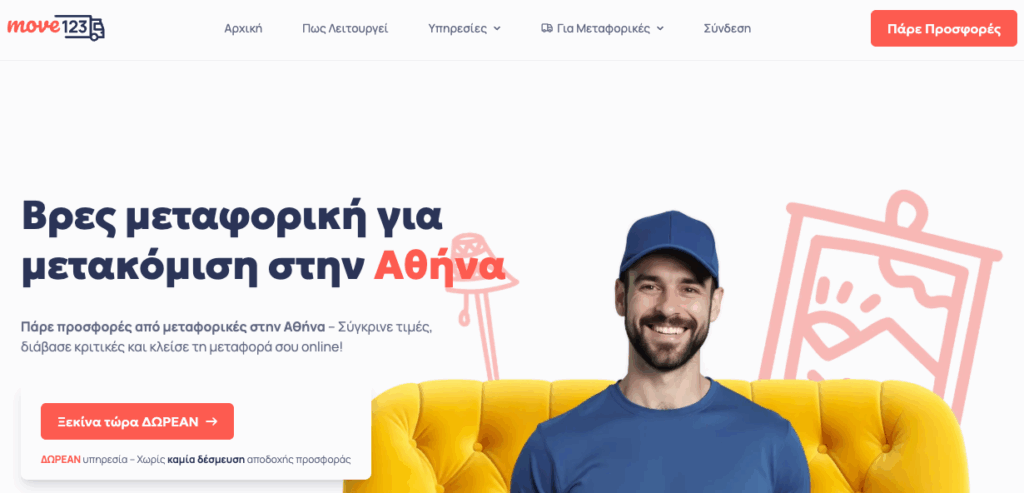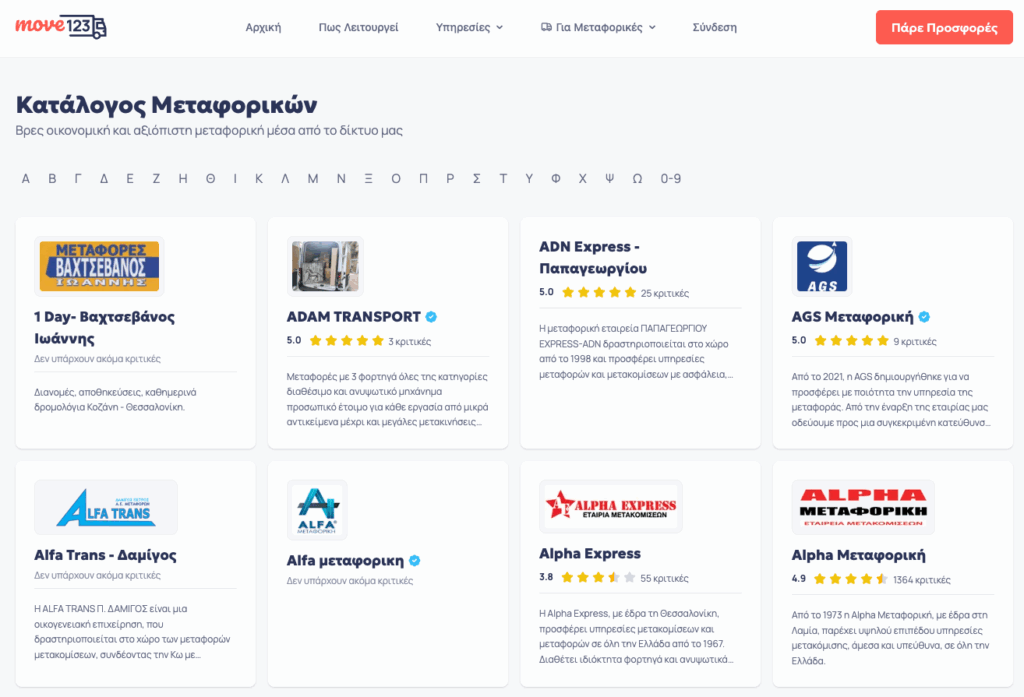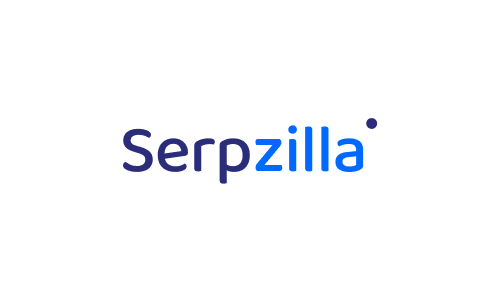Programmatic SEO (pSEO) sounds technical and intimidating, but it’s the most powerful lever a marketplace can pull for scalable organic growth.
The trick is how to scale pages but keep a uniqueness factor to target multiple long-tail keywords.
This is what we did for Move123.gr, a moving company marketplace in Greece.
We designed and launched their programmatic templates in January. Less than nine months later, the site is clocking nearly 3,000 organic visits per month in its target market.

The secret sauce?
Implementing multiple good practices quickly with well-planned pSEO templates.
Here’s the blueprint for how to plan your templates.
Stop Thinking About Keywords, Start Thinking in Patterns
The foundational mistake most people make with pSEO is treating it like traditional SEO, just with more pages. Essentially, producing more pages with AI or minor changes, creating a spam-heavy domain.
Programmatic SEO is about identifying patterns in long-tail keywords with (usually) low volume of searches in scale!
For any marketplace, these patterns usually combine a “main term” with one or more “modifiers.”
For Move123.gr it was the core term moving services – metakomisis.
The modifiers were cities & locations.
What you want to achieve in this this case is multiple pages in a similar structure, auto-populated with relevant information, in the logic:
[Service] + [Location A] + to [Location B]
This simple pattern, combining their core service with every possible location combination, unlocked thousands of potential landing pages.
Around half a million pages, with 200k indexed pages in this case.

Each one targets a highly specific, long-tail search query.
For instance, looking at their sitemap, you can see this pattern in action with real URLs for their moving services (metaforiki):
- /service/metaforiki/argos-peristeri/ (Targeting moves from Argos to Peristeri, a major suburb of Athens)
- /service/metaforiki/nea_sinwph-lamia/ (Targeting moves from the town of Nea Sinopi to the city of Lamia)
- /service/metaforiki/argos-rio/ (Targeting moves from Argos to Rio, a key suburb of Patras)
Of course, there are also the intra-city movings, those are moving from the same city to the same city, and were structured as:
- /service/metakomiseis-metafores/athina/
- /service/metakomiseis-metafores/thessaloniki/
Multiply that for around 600 locations of major cities, towns, and villages in Greece.
How to Build the Programmatic SEO Fundamentals
pSEO is like multiplication, you need at least two variables and you can start producing pages.
To achieve these, you need to:
- Prepare a database
- Design a page template
A Master Database
Your programmatic pages will only be as good as the data that feeds them. First, you need to identify the database.
For Move123, we had to build a database of all the locations in Greece. In our case, we started with the top 20 cities to test the templates, before expanding to all smaller locations in Greece.
Marketplaces can have databases for:
- Locations
- Product names
- Product types
- Colours
- Sizes
- Services
- Job positions…
… and much more, depending on the industry or niche.
Uniqueness
You also need to identify a uniqueness variable, this is not for the URL, but this is what will be added to each page.
While you can start simple and have the name of the City, that is not always enough for very competitive markets.
Here are a few examples to “spice up” your website with uniqueness that Google loves:
- Price variations
- Custom descriptions
- Sub locations
- UGC content (e.g. user listings per location)
- Addresses / P.O. codes
Design the Template(s)
You now need a template that will take the information from the database and create pages.
The template will dictate standardized content, but also the variables (bolds):
- Foldering e.g. /moving/
- Specific url e.g. the city such as /moving/athens or /moving/athens-to-thessaloniki/
- Internal copy e.g. <H1>: Moving company in Athens
- Text e.g. <p> Find a moving company in Athens.

The goal here is not just to stuff keywords in. The goal is to make each programmatically generated page the single best answer on the internet for that specific long-tail query.
Your template must be more than just boilerplate text with a few swapped-out words. It needs sections that allow your unique data to shine.
A winning marketplace pSEO template includes:
- A Dynamic Structure from URL to Copy: The template controls how variables are used everywhere.
- Foldering: Establishes a clean URL directory e.g., /moving/.
- Specific URL slug: Generates the unique part of the URL from data e.g., /moving/athens or /moving/athens-to-thessaloniki/.
- Dynamic Internal Copy: Populates the most important on-page elements e.g., <h1>Moving Company in Athens</h1>.
- Templated Body Text: Injects variables into paragraphs to create relevant copy e.g., <p>Find a moving company in Athens.</p>.
- An “At-a-Glance” Summary Box: Pull in key data points from your database right at the top. For Move123, this could be Location, Starting Price, Local Movers
- Unique Introductory Content: Generate a short, unique paragraph for each page. This can be scripted. Example: “Planning a move from Athens to Thessaloniki? Our network of 12 professional moving companies makes the 500km journey simple and affordable. See instant price estimates below.”
- The Core Marketplace Component: This is where you display the relevant vendors. Don’t just list them. Show their ratings, a key benefit, and a clear call-to-action.
- Route-Specific UGC: As mentioned, this is your moat. Create a section for Listings for those locations, showing other people requesting a move with multiple boxes, a fridge, a piano etc.
- Programmatic FAQs: Answer questions related to the specific query. You can create a template for this. Answer location or product-specific questions.
- Smart Internal Linking: This is crucial for helping Google discover your thousands of pages. Your template should automatically link to other relevant pages. For example, a page about moving from Athens to Thessaloniki should include links to “Moving from Athens to Patras” (another key route) and a link to the main “Moving from Athens” hub page. This creates a “hub-and-spoke” model that search engines love.*
*You ideally need most pages to be as close as possible from the home page. That means 3-5 clicks in page depth, pages that are further away have a higher chance not to be indexed.
**Short urls are also an advantage, and get picked & ranked more easily than long addresses.
Programmatically Build Your Vendor Directory
More than just creating pages for what users search for, a powerful pSEO strategy also involves showcasing the supply side of your marketplace.
For Move123, we programmatically built a complete, searchable directory of every moving company on the platform. This creates a second, distinct pSEO asset, because people may look for a specific brand or company, and you can re-direct this traffic to your other pages.
Also, it’s a bonus for increasing domain relevancy, by connecting a marketplace to well-known authorities in the niche.
The URL structure for these profiles is templated as well: /[category]/[company-name]/. You can see it in their sitemap for business profiles:
- /metaforiki/alfa-trans-damigos-dcec/
- /metaforiki/ydrogeios/

These pages are not just simple listings; they are rich profiles containing all the data you have on that vendor. Most importantly, we created a unique LocalBusiness Schema for this template.
This allows us to feed structured data directly to Google, including:
- Business name, address, and phone number.
- Services offered and areas served.
- Aggregate star rating, compiled from user reviews.
This specialized schema helps these profiles rank for branded searches (e.g., “Alfa Trans Damigos reviews”) and can earn rich snippets like star ratings directly in the search results, building immense trust.
These directory pages also serve as powerful hubs to link back to the city-to-city service pages where that vendor operates.
Plan the Launch in Batches
Finally, don’t publish 10,000 pages at once.
This is a red flag for Google and makes it impossible to debug.
Launch your pSEO strategy in logical batches. Start with your most important category or location. For Move123, this would mean launching all pages for routes originating from Athens first.
This allows you to:
- Check for indexing issues in Google Search Console.
- Monitor initial traffic and user engagement.
- Fix bugs in your template or data before scaling the problem.
Once you see the first batch getting indexed and ranking for long-tail terms, you can confidently roll out the next batch.
Technical SEO is Important
The foundations for pSEO websites are incredibly important. As we are creating thousands of pages, it takes a lot of resources from Google to crawl.
You need to:
- Have light-weight pages,
- Fast servers, and
- Well-structured pages
Relevant schemas are also important.
Here are some very important factors to consider when building programmatic websites, and why they are needed.
Fast Site Speed
A faster site means Google can crawl and index more of your pages in the same amount of time. Test your template page with Google’s PageSpeed Insights before you launch.
Re-use assets, keep image files small, and avoid too much Javascript.
Fast websites, means Google is using less resources to crawl your site, giving you an advantage. It’s an incentive to keep their costs low, and give you an advantage in ranking!
A User-Centric Design (UI/UX)
A clean, trustworthy design is crucial for a marketplace. Your template’s goal is to convert a visitor into a lead. If the page is cluttered, confusing, or looks untrustworthy on a mobile device, users will leave.
Great design is one of Move123’s superpowers, and keeps people browsing for longer, sending strong ranking signals back to Google.
Schema Markup
Schema is a type of code that explicitly tells search engines what your content is about. By integrating schema into your template, every generated page can tell Google:
- “This is a service,”
- “This is the price range,”
- “This is the average user rating,” and
- “These are frequently asked questions.”
This dramatically increases your chances of winning rich snippets in the search results.
Site Maintenance
Review, fix, and remove pages often, as it’s easy to create a bloated website and if Google starts no-indexing your pages, the traffic will also disappear as fast as it was created.
Conclusion
Programmatic SEO isn’t a shortcut.
It’s a strategic framework for turning your marketplace’s inherent data advantage into an untouchable organic traffic asset.
Plan deliberately, focus on providing unique value on every page, and nail the technical fundamentals.
Programmatic SEO requires a strong technical foundation, and the willingness to invest in technical resources.
But, it can only work if you have unique value to offer your users.







